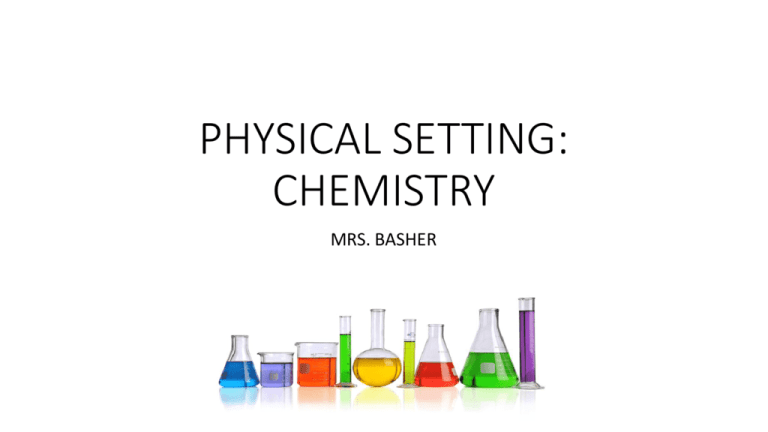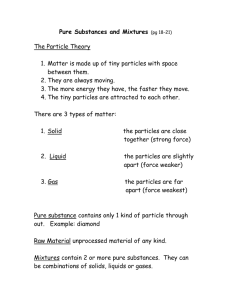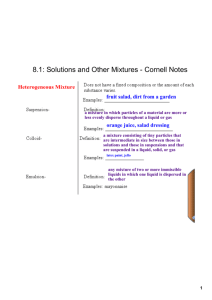PHYSICAL SETTING: CHEMISTRY
advertisement

PHYSICAL SETTING: CHEMISTRY MRS. BASHER ROOM 209 Mrs. Basher – Room 209 Contact Info: Email: Maureen.Basher@valleycentralschools.org Phone: 845-457-2400 Ext. 19231 Twitter.com BasherChem Facebook.com BasherChem What you will need for class: - 5 Subject Notebook - Pens/pencils - Chemistry Reference Table - Calculator (NOT a graphing calculator) - Colored Pencils - Markers - Small Scissors - Tape or glue sticks ( I don’t like glue sticks……) Class Expectations 1. Be on time 2. Be prepared with Notebook & Homework 3. Follow directions in Class & Lab 4. Ask Questions – Come to Review Class 5. Make-up missed work due to absence (This includes LABS!) LAB! New York State Lab Requirement: All students taking a Regents science course must complete the laboratory requirement. The Valley Central High School laboratory requirement consists of 90 laboratory periods which must be documented by student written reports. Lab reports must be handed in on time and receive a passing grade of 70. These lab reports will be kept on file by the teacher. Failure to complete this laboratory requirement will result in a student being barred from taking the midterm and regents exams and failure in science for the year. Midterm Exam Lab Deadline: Wednesday, January 14, 2015 Regents Exam Lab Deadline: Thursday, May 21, 2015 Student Grading: •Unit Tests/Quizzes •Labs •Homework •Class Notebook 60% 20% 10% 10% I. Chemistry A.The study of MATTER – structure, composition, and properties of matter B.The study of the CHANGES matter undergoes C.The study of the ENERGY that accompanies these changes II. Matter - anything that has MASS and VOLUME. Mass = the amount of matter (particles) in an object/substance. VOLUME = space A.Classification of Matter 1. Substance – type of matter that has identical properties & composition * All samples have the SAME characteristics * UNIFORM composition (same throughout) * 2 types of substances: Elements & Compounds a. Element – simplest form of matter * Cannot be decomposed by a chemical reaction • Represented by symbols • ex. C, Mg, Li, H • First letter of element symbol is capital, second letter is always lower case. • All known elements are listed on the Periodic Table of the Elements. See Reference Tables b. Compound * 2 or more elements CHEMICALLY bonded together * Element + Element ----------> Compound * Binary Compounds – made up of 2 elements ex. CO2, H2O *Ternary Compounds – made up of 3 or more elements. Ex. H2SO4, Fe2(SO4)3 *Compounds CAN BE decomposed in to elements COMPOUNDS Made up of 2 or more elements in a definite ratio. Rvw: SUBSTANCES ELEMENT • Simplest form of matter • Cannot be broken down • Represented by symbols • Listed on the Periodic Table COMPOUND • Two or more elements CHEMICALLY bonded together • CAN be broken down or DECOMPOSED into its elements • Represented by formulas 2. Mixtures – 2 or more substances with different properties and composition that are PHYSICALLY combined in varying amounts * They combine in NO definite ratio * Each substance retains its properties within the mixture. * There are two types of Mixtures: a. Homogeneous Mixtures b. Heterogeneous Mixtures a. Homogeneous Mixtures – have EVEN distribution of substances. Examples: Aqueous Solutions – Water solutions Tincture – Alcohol solutions Alloy – 2 metals dissolved into each other in the solid phase. Ex. Brass = Copper (Cu) + Zinc (Zn) Amalgam – a metal is dissolved in Mercury (Hg) *ALL AQUEOUS SOLUTIONS ARE HOMOGENEOUS MIXTURES* Homogeneous Mixtures • Aqueous Solutions • Water solution • Example: Salt + Water • Tincture • Alcohol solutions • Example: White Willow Bark + Ethanol Homogeneous Mixture • Alloy • Mixture of 2 metals • Example: Brass = Cu + Zn • Amalgam • Mixture of Hg + Ag + Sn + Cu • Example: Dental Fillings b. Heterogeneous Mixtures – Have UNEVEN distribution of substances. * Colloid – microscopic suspended particles in another substance. Example: Milk * Suspension – solid particles which are visible and able to settle out in the mixture. Examples: Iron & Sulfur – solid + solid Concrete – solid + solid Sand & Water – Solid + Liquid Oil & Water – Liquid + Liquid Heterogeneous Mixture • Colloid • Mixture with microscopic particles • Example: Fat molecules in Milk, Paint • Suspension • Mixture with larger particles that can settle out (sedimentation) • Example: Muddy Water, Ocean TYNDALL EFFECT: - is light scattering by particles in a colloid or particles in a fine suspension. - It is named after the 19th-century physicist John Tyndall. - Examples: Opulescent glass Separation of Mixtures – See Worksheet 1. Filtration 2. Evaporation 3. Distillation 4. Chromatography Examples of Regents questions: 1. Which formula represents a mixture? a.NaCl (aq) b. NaCl (s) c. H2O (l) d. H2O (s) 2. Which substance cannot be decomposed by a chemical change? a.Mercury II oxide HgO2 c. Potassium chlorate KClO3 b.water H2O d. Copper Cu Summary of Matter Classification: Matter Map







